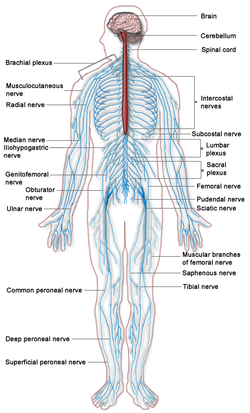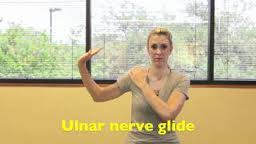What is a Nerve Glide?
by Jay Armstrong - September 2012
Have you ever thought about how extraordinary your nervous system is? The complexity of the brain is virtually incomprehensible with its 100 billion neurons. Each of these neurons has an average of 1000 to 7000 connections to other neurons. The capacity of the human brain is out of this world!
| But, here is something else amazing for you to think about. Our nervous system, including the brain, is essentially all one giant, interconnected nerve! The nerves in your left little finger continue without interruption all the way up your arm, through the upper spinal column to the brain. And, the brain is connected through the spinal column all the way to your right big toe. This means that ALL of the nerves in your entire body are connected together to form essentially ONE HUGE network of nerve cells! And, when you turn your head or bend your toes the nervous system’s network gets twisted and pulled. |
|
 |
 |
|
Nerves are pliable and can be bent without damage during our normal movements. They are also able to change length or be stretched. In fact, if the nerves do not stretch as they should the brain (or central nervous system) will prevent us from moving at our best. Peripheral nerves, the ones in our arms and legs, are encased in a protective sheath called the epineurium. As we move about, the nerve slides inside this protective sheathing. Part of good health is supplying our bodies with the appropriate nutritional intake to support the regeneration of these materials. Another part of maintaining a healthy body is movement. Yes, this includes the nerves along with the muscles, tendons, ligaments and joints. |
Our nerves are designed to slide inside their protective sleeves and the way to maintain this ability is through movement. Our bodies are constantly adapting to the demands we place on them. If we do not move, we will adapt so that we become better at not moving. So, the clear lesson regarding our peripheral nerves is that we must elongate them in order to maintain their health.
| The human body is composed of a wide variety of different types of tissues: bones, cartilage, skin, fascia, etc. All of these tissue types must work together to support our movement. Bones provide strength. Cartilage cushions and connects the bones at the joints. And, as we move, the skin, fascia, and the nerve network must all stretch to allow whatever movements we attempt. Whether we are throwing a ball or bending over to pick something up, muscle, skin, fascia and nerves are all stretching to allow the activity. If one of the tissues will not stretch adequately, the central nervous system will not allow us to perform the movement. This is a built-in safety mechanism that helps prevent damage to the body. |
|
 |
Neurodynamics, neuromechanics, nerve stretching, or nerve glides all refer to the physical-mechanical process of moving parts of the neural network. Muscle stretches will generally provide some stretching of the peripheral nerves. Nerve glides are specifically designed stretches that allow the practitioner to elongate segments of the peripheral nervous system. As a result, nerve glides may seem like very unusual stretches.
 |
|
Maintaining the health of the peripheral nervous system will pay big dividends. Improved signal conduction to the muscles, increased sensory perception, and greater range of motion are just some of the benefits that are likely from regularly practicing nerve glides.
|
For more information regarding nerve glides, check out books or references on Neurodynamics or Neuromechanics. Or, you can contact your nearest Z-Health Trainer.
References:
Kimberly S Topp and Benjamin S Boyd, “Structure and Biomechanics of Peripheral Nerves: Nerve Responses to Physical Stresses and Implications for Physical Therapist Practice”, 2012, http://ptjournal.apta.org/content/86/1/92.full#sec-1
Z-Health Master Trainers: http://www.zhealth.net/master-trainers
|